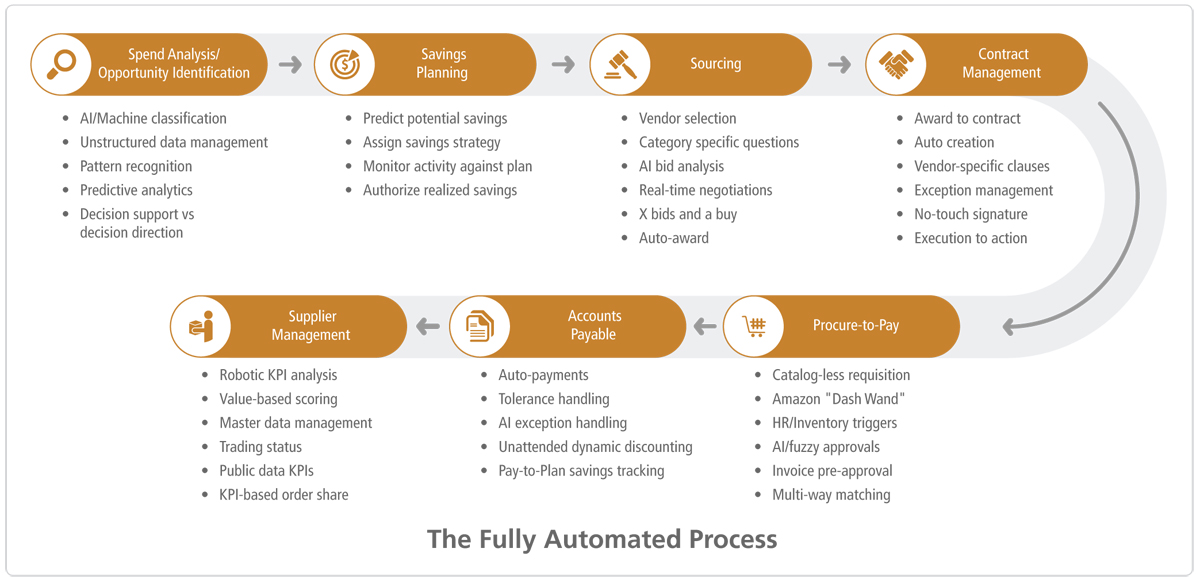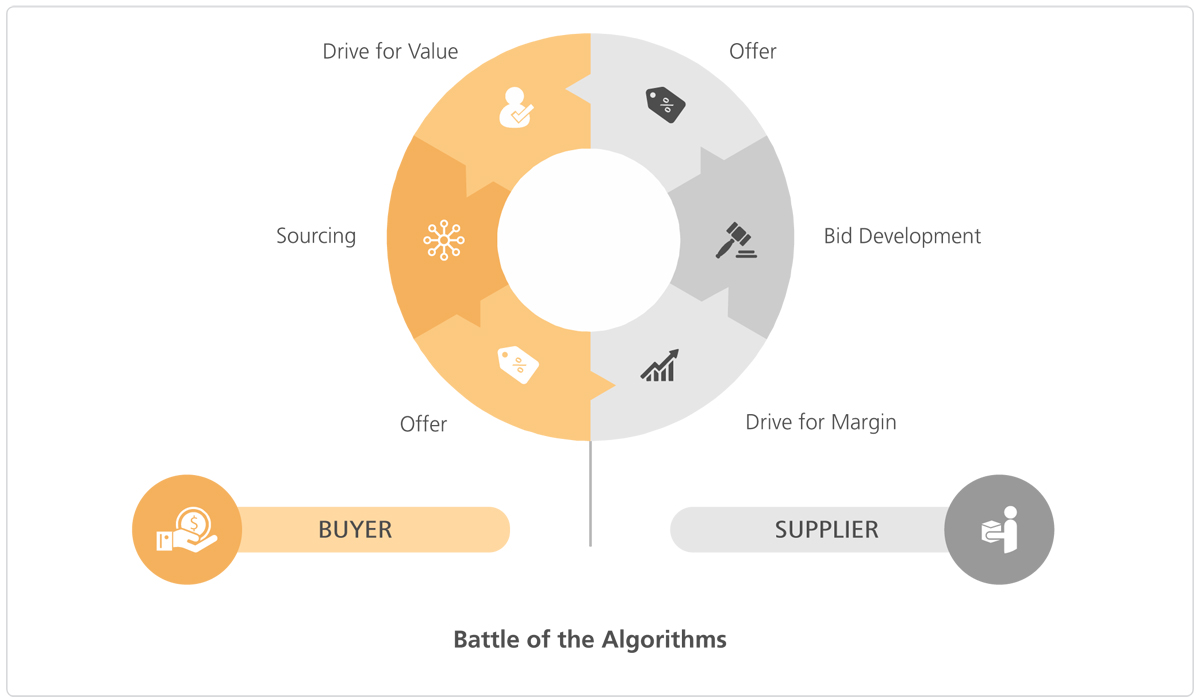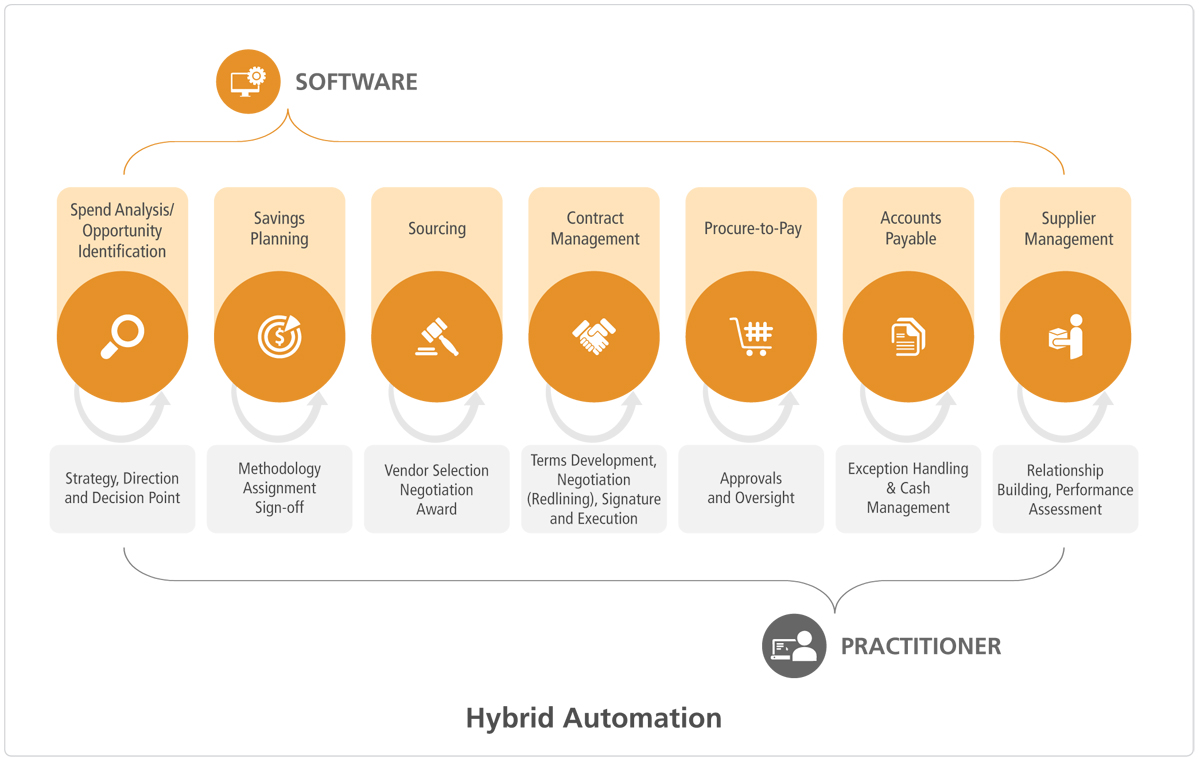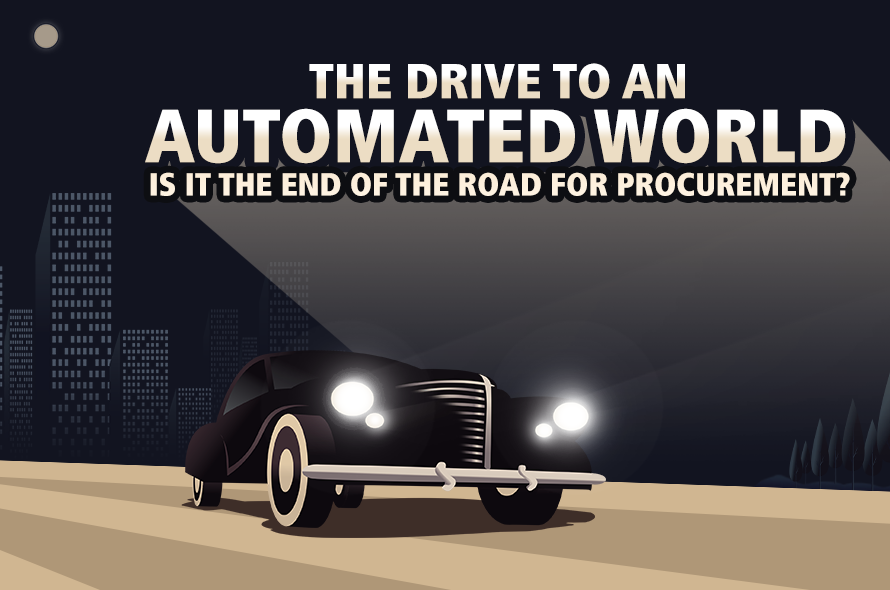Introduction
In this age of impatience, expediency and constant preoccupation, the need for automating mundane, monotonous processes to improve ease and efficiency is fast becoming a pressing one. For procurement, automation could mean doing away with expensive and tedious manual tasks, such as data management or value-based scoring, thereby driving productivity and cost savings.
Modern advancements in technology suggest that we might already have the firepower to develop a software platform which automates most of procurement’s functions. But, is completely automating procurement the solution? Would we continue to be as innovative and receptive to change in a fully automated environment or will it take away a bit of our flexibility? More importantly, how should we best approach procurement automation to really make it work for us as a sustainable value addition?
In this white paper, GEP’s experts attempt to answer these questions and more, as they envision the impact of automation on procurement.
Automating Procurement
The prospect of automation can be quite unsettling despite the many conveniences it offers. Depending upon your point of view, extreme process automation might either be unequivocally the best thing that can happen to a business or simply the worst thing imaginable. The reality, of course, lies somewhere in between. And, in many cases, the possibilities of automation are somewhat separated from the actualities.
Although there is no clear consensus on what exactly automation means, it usually tends to be synonymous with supplanting human activity. And while its impact on employment cannot be denied, humans have always discovered extraordinary ways of finding things to do. Given the current rate at which technology is advancing, it is perhaps plausible to speculate that by 2030, around 90 percent of the jobs we know today will be automated.1 In fact, many of the service provisions now are totally different to what they were a few decades ago.
In procurement, like all jobs and processes, change is almost certainly inevitable and the move to an increased hands-off kind of automation is highly likely to be a big part of that change. In this paper, we’ll examine the theory – what could be automated, the rationale – why we might want to automate different processes, and the likely reality – what the situation is today and where we think it is heading. To cut to the chase early on, we think that reports of the procurement department’s demise are rather premature. Despite the technical feasibility of removing human activity from the supply chain entirely, if history teaches us one thing, it’s that the evolution of working practices is messy, piecemeal, start-stop and subject to unexpected perturbations that were never part of the plan.
There is a reasonably persuasive argument that automating the entire supply chain would maximize efficiency, eliminate all overheads and reduce costs to a minimum. This argument presupposes a number of things, not least the compliance of all parties in the extended supply chain, across borders, across political ideologies and across the spectrum of business motivation. Persuasive as that argument may be, it’s perhaps harder to contemplate a future in which the innate chaos and messiness of global business could be sufficiently normalized to allow for a purely robotic supply chain.
Whatever the distant future holds, for the time being, humans will remain relevant and core to the process. What isn’t so certain is precisely what that process will look like and which parts of today’s source-to-settle landscape it will encompass.
Why We Might Want Automation in Procurement
For a start, the laborious processes and paperwork of recent years are simply not appealing, in addition to being time consuming, expensive and at times, downright counterproductive. In fact, procurement professionals should neither be surprised nor resistant to such development since procurement, after all, is about eliminating inefficiency, maximizing value and getting rid of the unnecessary.
Another reason might be our low tolerance for administrative overhead resulting from modern day convenience and utility. The general expectation is that business processes should be better than they are and complement other modern experiences.
Why Do We Need Automation in Procurement?
It’s all about efficiency. Automation in heavy industry is about lowering cost, eliminating errors, ensuring consistency, enforcing quality and increasing throughput. Procurement need not be any different. The fact is, in far too many enterprises, a great deal of resources are spent on processes that are fundamentally inefficient, in that they take time and mental power to complete.
Automation then could act to radically release human resources from otherwise mundane and repetitive processes. These processes, once automated, could be further subject to more rigorous and similarly automatic quality and error checks, and conducted at higher, machine-like speeds.
Why We Might Not Want Automation in Procurement
As with most things, it is prudent to take a good long look at what automation might entail, to ensure that the right processes become focal points.
One apparent risk is that by encoding a process into a series of machine steps, the ability to innovate and react to change is lost. The manner in which catalogs have become fused into the procurement process is a good example. Electronic catalogs were created to simplify purchasing, enforce compliance, normalize the requisition-to-check process and transfer some of the administrative burden to the suppliers, thus freeing up resources. However, the inflexibility of static catalogs could lead to users by-passing the system to get what they know to be a better deal. Too much structure in a dynamic environment could lead to increased maverick spend. In the future, procurement software could have access and the ability to process unstructured supplier and product data, allowing catalogs to be updated dynamically and providing buyers with virtually unlimited options.
Considering the bigger picture, if we were locked into one mode of decision-making across the entire source-topay life cycle, surrendering control to artificial intelligence (AI) doesn’t seem like such a liberating idea.
In addition to potentially stifling innovation, automation could overwhelm some parts of the business. For instance, a high-speed automated procurement process could deliver invoice after invoice to the accounts payable team, without contemplating the consequences. Therefore, no matter how fast and efficient the source-to-contract process becomes, its primary purpose is defeated if everything breaks down when it comes to utilizing those contracts.
What Could Be Automated in Procurement?
In terms of technical possibilities, major portions of the end-to-end procurement process could actually be automated. This includes a number of steps and sub-processes — from initial analysis to ongoing supplier management.
 Spend Analysis & Opportunity Identification
Spend Analysis & Opportunity Identification
The technology exists today to automate a good deal of the analysis that, in the past, consumed a lot of time and resources. Trawling previously chaotic and unstructured spend data, seeking opportunities for supplier rationalization, savings or other value can now be a fully or partially automatic process with human intervention limited to defining the size and scale of the relevant target opportunity. But even that could be developed into the logic to make for purely automated analytical opportunity finding. The move then is from decision support to decision-making, at an automated level.
 Savings Planning
Savings Planning
Once the opportunity definition is automated, the next step is savings planning and management. In a fully automated context, opportunities could be flipped into saving projects and assigned an appropriate set of tactical methodologies to deliver results. This is where much of today’s effort is concentrated. We know what we have to achieve, but how to do it precisely is a matter of expertise and skill.
Even so, any thought process could be captured as an algorithm and it’s not a great leap to imagine a standard set of sourcing activities, protocols, or tactics to deploy for any opportunity that arises. Again, the technology exists today to make savings planning fully automated.
Tracking performance against plans and ticking the box as the savings milestones are reached is just a natural extension of what the software could do. For savings however, the plan, the procurement system and the finance system must all work in synchrony.
 Sourcing
Sourcing
In the next stage of the process, a “savings management robot” could decide which sourcing model to employ, select vendors, instruct the bidding process, analyze the results and conduct real-time multiround negotiations. In such a scenario, there is no reason to limit best practice to three bids and a buy, since the software could ask for 10 bids.
Matching the best bid against historical benchmarks or predefined criteria could allow the software to automatically award a contract to the best supplier and also generate one, just moments after the sourcing process is complete.
 Contract Management
Contract Management
It is not unreasonable to suppose that a standard form of contract for the category in question should be automatically selected at this point. In fact, this is already a feature of today’s software — once a sourcing event has been completed and a winning supplier has been selected, the user could click “flip to contract” and the software will automatically select the right template and build a draft contract. But the fully automated version might go a step further. Supplier amendments to the terms could be accepted or rejected according to a logic based on the history of similar contracts. If the contract matches the authorization rules, it could be appended with a signature and executed immediately.
The activity of executing a contract has largely implied, filing it and forgetting about it, barring the occasional reference to ensure adherence. But in an automated future, executing a contract will ensure that requisitions raised for goods or services are automatically routed to the contracted supplier at the agreed pricing.
 Procure-to-Pay
Procure-to-Pay
For several years, electronic catalogs have been an inseparable part of the Procure-to-Pay (P2P) process. But in the automated future, they might become redundant. Unstructured data is now searchable and the smart algorithms that are under development in the industry will mean that finding what’s needed at work will be no different to how it’s done at home. Maverick spend could effectively be eliminated because the software would know the identity of buyers and the approved suppliers. Like a real-time catalog, the P2P software of tomorrow will present only those items that are authorized.
As for raising a request, technologies exist today to rapidly accelerate the process. Amazon’s Dash is an example. The device’s buttons are nothing more than rapid requisition creators, like a macro squeezed into a one-click key. The Dash Wand is designed to facilitate scanning and voice recognition to accelerate the step from demand to order. Demands that are triggered by activity in the organization, such as new employees, office moves and project activities could just as easily be transformed into orders automatically by triggers from the relevant HR or inventory systems. Once created, the only difference between a requisition and a confirmed order is approval and authorization. Automating that also represents no real technical challenge. An AI or logic-based approval process that mirrors the decision making of current management structure could significantly shorten the demand-to-delivery cycle time.
 Accounts Payable
Accounts Payable
In the automated future, commodity-based orders, derived from negotiated contracts could naturally lead to standard invoices. A fully automated procurement system might present the supplier with a preapproved pro forma invoice to flip back with their shipping notice. In this way, the entire transaction could be multiway matched.
For Accounts Payable (AP), the process is only just beginning. Since the incoming invoices are all fully matched, payment could be automated as well. Variable commodities and services could be matched according to tolerance rules and, once again, AI may play a part in handling exceptions.
Today, AP departments can take advantage of variable cash flows and using cash availability as an advantage, create additional value through dynamic discounting. That again, could be automated with an algorithm balancing cash-on-hand against the invoice queue and the discounts that might be on offer for early payment. Each payment then, connected all the way back up the chain, is a validation of the realized savings set out at the beginning of the process.
 Supplier Management
Supplier Management
Finally, measuring supplier performance and adherence to terms becomes an inevitable part of the process. When all else is automated, any deviation from the plan caused by the supplier is a black mark on their card. But determining supplier suitability in the first place could also be derived from data in the new world of full automation. When linked to the wider world of unstructured supllier intelligence, procurement software could appraise suppliers and rank them for trading, based on a huge range of criteria, thereby driving responsible procurement, reducing risk in the supply chain and delivering the lion’s share of business to those suppliers who fit the bill — all without any human intervention. This, then, is an entirely automated supply chain. It drives maximum value for the business, reduces risk and cuts administrative overheads to the bare minimum.

Should Everything That Can Be Automated Actually Be Automated?
While building an entirely automated supply chain is technically possible, is it truly what we want and need?
One deterrent could be that extreme automation could lead to a battle of the algorithms. A fully automated supply chain could end with one system negotiating with another in an infinite loop. In such a scenario, there might no longer be any benefit to be derived from sourcing activities at all. Extreme automation could thus drive today’s main purpose of structured procurement into extinction.
Moreover, one hundred percent automation, while technically feasible, is unlikely to ever be desirable because once people disconnect themselves from the process, they lose the ability to innovate — and innovation is critical to stay relevant in a changing world.

What Should Be Automated Today?
GEP's experience of procurement as a world-leading team of practitioners brings to light that real value in procurement processes derives from human action and intelligence. The purpose of automation is to accelerate tasks, remove errors and minimize risk from relevant processes. It has a role to play in decision support but flexibility must be maintained to allow for intervention and innovation.
Authorization, strategy selection, supplier relationship management and financial control should stay under human control because in those areas and others, the people component is where the real value to the business lies.
At every stage, expert oversight, analysis, decision-making, authorization, negotiation, planning and relationshipbuilding skills are what will enable the automated process to deliver value faster and greater than before. This then is a hybrid model of automation which balances human intervention and artificial intelligence in a manner that optimally utilizes both elements.

Automating Correctly
While considering the prospect of deploying a hybrid system, it is important to understand the key factors essential for achieving the right kind of automation.
Look for the Right Solution
ERP systems are simply no longer up to the task required by a modern procurement practice. What they bring to the table as strength in an operational context becomes an inflexibility in a more rapidly evolving business. However, it is a mistake to try and shoehorn an on-premise legacy system into a role that calls for something far more configurable. Not recognizing the inertia that ERP systems come with, and assuming that everything can continue as it always has is a huge risk. It is clear that the only place to look is in the cloud. All business systems are heading that way and now it is procurement’s time.
Inevitably, the mission-critical MRP and resource management systems will migrate to the cloud as well — although this will take slightly longer. But radical new technologies like Blockchain and the extraordinary scalability that the cloud offers will make this a certainty. Fundamentally, what a cloud solution provides is freedom from the legacy of a bad decision.
People Will Make the Automated Process Work
Deploying a software system to deliver a high degree of process automation will free up headcount. But it might be a missed opportunity to see that as a top-line cost saving.
Removing the shackles of administration from people could actually free them to create more value in the supply chain. On taking a view of the automation process, synergies can be driven from the software and the new flexibility people have, turning a potential human cost into another driver of savings and ROI.
The Software Does Nothing of Value Unless Built Around Your Business
It is also critical to remember that software today will do nothing of value unless it is molded around a business. Therefore, part of the selection criteria must entail an understanding of whether the software can work the way you need it to, and also if you can work in a manner that it demands.
Best Practice in Achieving Automation
Some of the key considerations in any implementation are processes, design, data and scale. Bearing that in mind, it is important to consider the following criteria for successful deployment.
 Fix the Process
Fix the Process
The importance of paying attention to the whole process cannot be overstated. Take the time to work out how things should happen, taking a holistic view across functional and geographic boundaries and build a process that’s fit for purpose. It’s almost always a mistake to just overlay automation and technology on top of an existing process. True procurement automation isn’t about making a broken process run faster.
 Design for Success
Design for Success
When it comes to designing a procurement system to be a solution, it is prudent to build in flexibility at the earliest stage so that when the business changes, there is no need to go back to the drawing board. Designing in flexibility at the get-go can allow you to respond better to unexpected changes.
 Understand the Data
Understand the Data
An understanding of one’s data landscape as it exists today is just as important as a vision of how it should be seen tomorrow. Projects like these often start with the selection of a software provider. The contention, however, is that irrespective of the supplier, it is worth starting the ground work well ahead of time. Implementation can be faster and better if the available data is cleaned and parsed upfront.
 Understand the Scale
Understand the Scale
Understand the true scale of what has to be achieved. Without a proper understanding of scale, it is very likely that a complex “all-up” integrated solution could unnecessarily be designed when a far simpler model would have achieved just as much. On every level, user impact, change management, systems interoperation, data volumes, and even cash flow — it is important to understand the scale and scope of the proposal.
 Remember the People
Remember the People
People are exceptionally important in the process and not just sponsors and stakeholders in procurement. Understanding and appreciating the impact of change on them is strongly advised.
Consider The “Whole Process”
Ever since the dawn of the industrial age, automation has threatened to supersede labor-intensive jobs, creating an atmosphere of unrest, uncertainty and pessimism about the future. When technology brought us the first computer, it accrued a similar reception. However, we now know that most of those concerns were rather premature as automation did not just take jobs, but also created new ones. And irrespective of whether procurement attains a higher degree of automation, the human role in the process is expected to remain vital. So, in effect, the scope and scale of automation might expand but predictions that work and workers would become obsolete are rather unfounded.
As we have learned, the technology exists today to set us on a path to total automation and some even consider this inevitable and desirable. Whatever current trends and developments may be, one thing is certain — today’s predictions are unlikely to be borne out exactly. The reality is that the complexity of today’s supply chain will not diminish in the near future and that will provide a brake to the charge for automation. Procurement’s role would be to leverage automation capabilities as they arise for the benefit of the business, but maintain a keen and critical eye on global and local influences to ensure innovation in tactical and strategic operations. For the foreseeable future, procurement will remain highly relevant as long as it can remain adaptable at the same time.
In conclusion, it is necessary to reiterate the importance of considering the whole, end-to-end process, because the entire process efficiency is governed by one rate-determining step. For this reason, organizations must pay attention to the ownership of each part of the process. Full process transformation is a communal activity and the business that plans together, saves together.
Endnotes:
- Kenneth F. Brant, Anurag Gupta, and Dan Sommer, “Maverick“ research: Surviving the rise of ‘smart machines,’ the loss of ‘dream jobs’ and ‘90% unemployment’, Gartner, September 23, 2013, no. G00253498.

